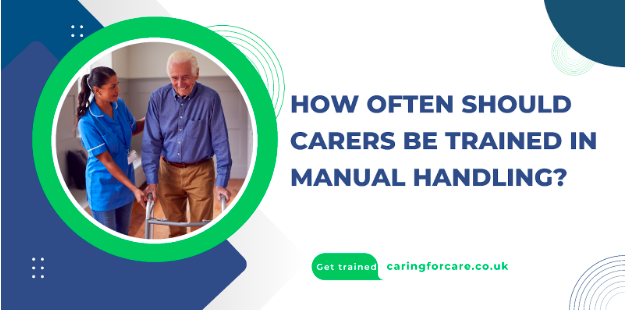Paras Mehta
Blog entry by Paras Mehta

The frequency of manual handling training for carers can vary depending on several factors, including local regulations, organizational policies, and best practices in the healthcare industry.
While there is no one-size-fits-all answer to how often carers should be trained in manual handling, industry standards and expert advice provide some guidance.
It's important to note that while these are general guidelines, the specific requirements can vary:
-
In the UK, the Health and Safety Executive (HSE) doesn't specify a fixed timeframe but emphasizes that training should be repeated "periodically where appropriate," and refresher training should be "provided on a regular basis."
-
In the US, requirements can vary by state and the specific healthcare setting.
-
In Australia, SafeWork recommends refresher training at least every two years.
Care home managers should consult their local regulations and industry standards to ensure compliance.
Additionally, they should consider implementing a system for ongoing competency assessments to identify when individual carers might need additional training or support.
Below are several factors that determine the frequency of moving and handling training:
Stay compliant and provide the best care possible. Talk to our team about moving and handling training for yourself and your team.
It is recommended that you get adequate support and training before starting a job in care that involves supporting an individual with mobility issues.
Now let’s go ahead to discuss the factors that determine the frequency of moving and handling training for carers.
1. Initial Training and Induction
When a carer starts a new job, they should receive comprehensive manual handling training as part of their induction.
This ensures they are fully aware of the proper techniques and safety measures before performing any manual handling tasks.
This initial training should include hands-on practice, theoretical learning, and assessment to ensure competence.
2. Annual Refresher Training
It is widely recommended that carers undergo refresher training in manual handling at least once a year. The Health and Safety Executive (HSE) suggests that refresher courses help carers maintain their skills and keep up-to-date with any changes in best practices or equipment use.
Some guidelines suggest refresher training every 1-3 years, depending on the carer's role and the risks involved.
Regular retraining reinforces the correct techniques, reminds carers of the risks, and ensures their knowledge remains fresh.
3. Changes in Legislation or Best Practices
If there are significant updates to health and safety legislation or changes in best practices for manual handling, carers should receive updated training.
This helps ensure compliance with new regulations and enhances workplace safety.
For example, if new equipment is introduced, carers should receive specific training on how to use it correctly.
4. Risk Assessments and Observations
Employers should regularly assess the manual handling tasks that carers perform and observe whether they are following correct procedures.
If it becomes clear that carers are struggling with tasks or not following proper techniques, immediate retraining may be necessary, regardless of when they last completed a course.
Regular supervision and assessments help identify gaps in knowledge or unsafe practices.
5. Changes in Work Environment
Changes in the work environment can also trigger the need for manual handling training.
For example, if carers are transferred to a different department or begin working with patients with more complex mobility needs, retraining may be necessary to address these new challenges.
6. Following an Incident or Near Miss
If a carer is involved in a manual handling-related incident or a near miss, they should receive immediate retraining.
This helps to address any mistakes or misunderstandings that may have contributed to the incident and ensures the carer is better equipped to handle future tasks safely.
7. Employee Feedback
Carers themselves may identify the need for retraining.
If they feel uncomfortable or unsure about certain manual handling tasks, or if they find new challenges in their roles, they should be encouraged to request additional training.
Open communication between carers and management is essential for ensuring ongoing competency.
Benefits of Regular Manual Handling Training
Regular training is crucial for ensuring carers are confident and competent in manual handling tasks.
The key benefits include:
-
Reduced Risk of Injury: Carers who are regularly trained are less likely to suffer from musculoskeletal injuries or cause harm to patients. This leads to fewer days lost to injury and lower compensation costs.
-
Improved Care Quality: Carers who are well-trained in manual handling can provide better care. Patients experience less discomfort and distress during movements, and carers can focus more on their overall well-being.
-
Enhanced Morale and Retention: Employers who invest in ongoing training demonstrate their commitment to staff safety and development, which can lead to higher job satisfaction and lower turnover rates.
-
Legal Compliance: Ensuring that carers are trained regularly helps employers meet their legal obligations under health and safety regulations, reducing the risk of fines or legal action.
Conclusion
While there is no strict legal requirement dictating how often carers should be trained in manual handling, the best practice is for carers to receive initial training upon hiring and refresher courses at least annually.
Additional training may be necessary following changes in the work environment, equipment, legislation, or in response to incidents or staff requests.
Ultimately, regular manual handling training is essential for creating a safe and efficient working environment in the care sector, benefiting both carers and those they look after.
By prioritising ongoing education and skill development, employers not only fulfil their legal responsibilities but also promote long-term success and well-being for their staff and patients alike.